Just the mention of a multi effects unit evokes mixed reactions from guitarists and bass players alike. Purists will shun them, because “analog is always better”, while others, who value functionality, portability, versatility, and a much lower cost than a fully stocked analog pedalboard, will swear by them. This discussion won’t go away anytime soon, but the fact is this, multi effects pedals have gotten very, very good in recent times. So good in fact, that in blind A/B tests of similar effects you would probably have a hard time picking out the multi effects unit.
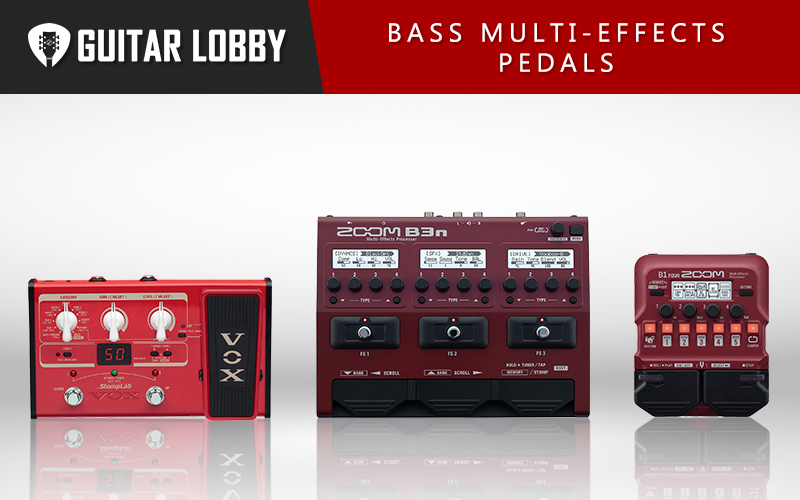
As a consequence, more and more gigging bass players will prefer a good bass multi effects pedal to a heavy and cumbersome traditional pedalboard. The only problem is that newcomers to bass effects could have a hard time picking the right pedal for their needs as the market is flooded with options, and every big pedal maker usually offers effects-processors in multiple tiers, adding to the confusion. Here’s where we come in! To make it easy for you, we’ve selected the best bass multi effects pedal at each price point.
I’ll start this article by jumping straight into reviews, but if you want to learn more about bass multi effects processors before reading reviews, check out our buying guide at the bottom of the page.
| Name of Product | Image of Product | Description | Price Range | Full Review |
|---|---|---|---|---|
| 1. BOSS GT-1B Bass Effects Processor (Best Value) | 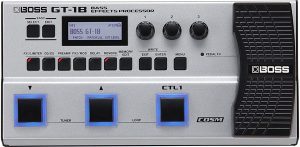 | Type: Digital Multi-Effects Processor Effects: 90 effect types | $220 | Read Full Review Below |
| 2. VOX Stomplab 2B Bass Effects Processor (Best Under $100) | 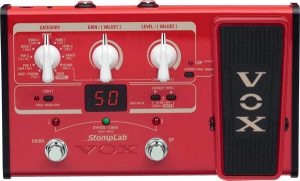 | Type: Digital Multi-Effects Processor Effects: 61 effects stored in 100 preset slots, +20 user-defined | $90 | Read Full Review Below |
| 3. Tech21 Bass Fly Rig (Editor's Choice) |  | Type: Analog Multi-Effects Pedal Effects: 7 analog effects with chromatic tuner | $300 | Read Full Review Below |
| 4. ZOOM B3n Multi-Effects Processor | 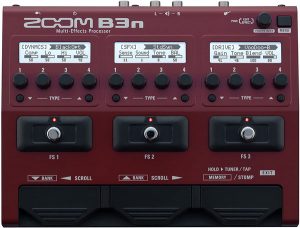 | Type: Digital Multi-Effects Processor Effects: 62 digital effects + 5 amp and 5 cabinet simulations | $220 | Read Full Review Below |
| 5. Fender Downtown Express Multi-Effects Pedal | 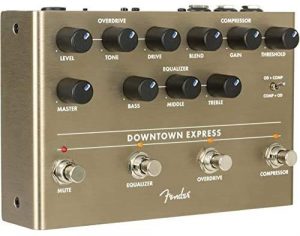 | Type: Analog Multi-Effects Pedal Effects: Preamp/EQ, Compressor, Overdrive | $250 | Read Full Review Below |
| 6. ZOOM MS-60B Multistomp Multi-Effects Pedal | 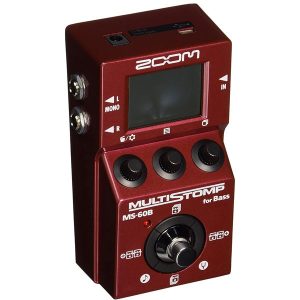 | Type: Digital Multi-Effects Processor Effects: 52 stompbox effects, 6 amp models | $120 | Read Full Review Below |
| 7. Valeton Dapper Bass DI | 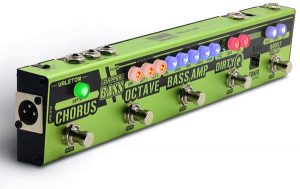 | Type: Analog Multi-Effects Pedal Effects: 5 analog effects | $150 | Read Full Review Below |
| 8. Zoom B1XFour Bass Multi-Effects Processor | 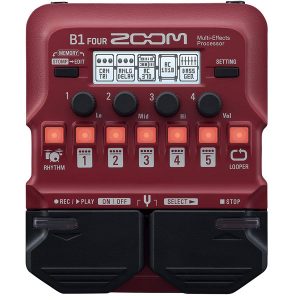 | Type: Digital Multi-Effects Processor Effects: 70 effects, 9 amp models | $110 | Read Full Review Below |
| 9. MXR Sub Octave Bass Fuzz | 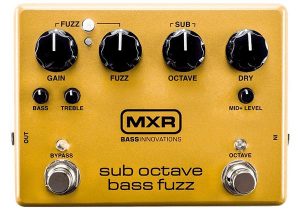 | Type: Analog effects pedal Effects: 2 effects | $200 | Read Full Review Below |
| 10. Zoom B1on Bass Multi-Effects Pedal | 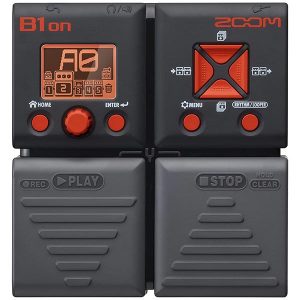 | Type: Digital Multi-Effects Processor Effects: 75 effect types and amp models | $100 | Read Full Review Below |
Here Are the Best Bass Multi Effects Pedals
1. BOSS GT-1B Bass Effects Processor (Best Value)
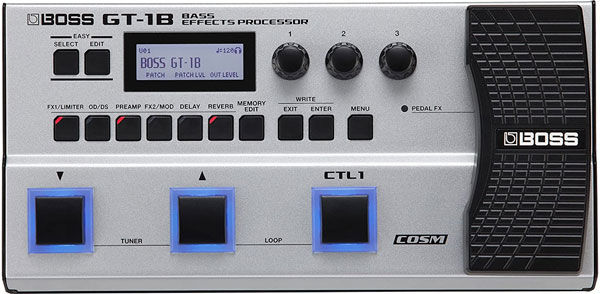
Estimated Price: $220
Type: Digital multi effects Processor
Effects: 90 effect types
I/O: 1x¼” input, 1×3.5mm aux input, 1x¼” L/Mono output, 1x¼” R output, 1×3.5mm headphone output, USB B port, 1x¼” CTRL/EXP in
Power: 200mA@9V PSU (not included) or 4 AA batteries (included)
My Review: Boss was one of the first pedal makers to capitalize on the multi effects craze of the 1990s. Since then they’ve continued to manufacture well-built multi effects pedals with incredible sounds and features. As a testament to their legacy, the GT-1B is packed to the brim with useful features and it will fit into almost any gig bag. It features a plethora of bass-oriented effects such as compressors, limiters, overdrive, distortion, chorus, flanger, synths, with different options and flavors for every one of them, and even a 32-second looper. It’s got three footswitches and an expression/volume pedal. The three control knobs situated on the upper-middle section of the pedal, let you alter the parameters of the selected effect type displayed on the LCD screen. The simplest form of navigating the pedal is through the “easy” section, consisting of two buttons located on the top left side. These let you browse through the effects organized by music genre or effect type.
A more detailed exploration can be achieved using the square-shaped buttons under the LCD screen. A quick tap on one of these engages its function while holding it down displays its controls on the LCD. The FX1, FX2, and Delay buttons have menus that let you assign different effects to them, while the memory edit button lets you reposition the effects in the signal chain to your liking. Navigating through the 99 presets and 99 user-defined ones is achieved with the left and middle foot switches labeled with the up and down symbols. The same two footswitches will engage the tuner when pressed simultaneously. The CTL1 footswitch can be assigned to perform one of many functions, such as engaging a solo boost, tap tempo, engaging different effects, and so on. The looper is engaged by simultaneously pressing the UP and CTL1 footswitches. All other looping functions are then performed by the CTL1 switch. You can also connect external footswitches to the GT-1B, further expanding its functionality. The USB type B port lets you connect it to a PC, where you have a more comprehensive overview of the effects parameters, making editing much easier. The same port lets you download user profiles created by various artists. The GT-1B offers a wide selection of sounds ranging from the useful to the extreme. All in all, the sound quality is excellent and the customization options don’t leave much to be desired.
Key Specs: The BOSS GT-1B is a digital bass multi effects processor housed in an aluminum enclosure. It features three footswitches and a volume/expression pedal. It features 90 types of effects stored in two banks of 99 presets each, one of the two banks is user-definable. It also has a 32-second looper and doubles as an audio interface so you can record straight into your preferred DAW. It has stereo outputs enabling you to send your signal to two different amps. Aux in lets you jam to your favorite tracks, while the headphone jack enables you to practice in silence. The GT-1B can run either on 4 AA batteries for about 7 hours, or on a 9V PSU (not included) drawing 200mA.
Target Customer: The GT-1B is a high-quality multi effects processor with a wide range of sounds and a lot of useful features. It’s an ideal companion on live gigs and it doubles as an audio interface making recording with it a breeze. It’s fairly intuitive to use straight out of the box but reading the manual will open up a whole world of functionality. It’s a great choice for any level of bass player, from novice to pro.
Bottom Line: The GT-1B is a great pedal in a relatively compact housing that will fit into most gig bags. It offers great sounds, functionality, and versatility at the price of some higher-end single effect pedals.
2. VOX Stomplab 2B Bass Effects Processor (Best Under $100)
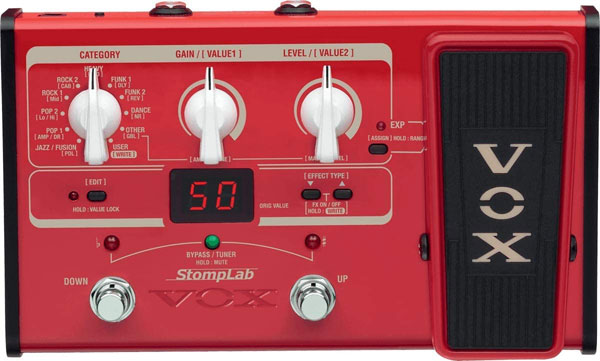
Estimated Price: $90
Type: Digital multi effects Processor
Effects: 61 effects stored in 100 preset slots, + 20 user-defined
I/O: 1x¼” input, 1x¼” stereo output /headphone output
Power: 9V PSU or 4 AA batteries
My Review: The Vox Stomplab 2B is a great example of how far multi effects units have come since their inception. It offers great quality tones, extreme portability and it comes with a very affordable price tag. Its diminutive dimensions of 8 ½” by 5” can sometimes detract from its ease of use but its portability and versatility more than make up for it. The Stomplab 2B features two footswitches to navigate through the individual tone banks, and it’s also equipped with a volume/expression pedal (also on the smaller side). There are a total of 61 effects, amp, and cabinet emulations to play around with, stored in 100 preset slots plus an extra 20 that are user-definable, with a maximum of 8 effects at the same time. As the LED display can only show two digits, you’ll have to read through the manual to understand what readouts correspond to what effect or emulation, but it’s fairly intuitive once you’ve gone through them once. The Stomplab 2B is one of the simplest processors to use straight out of the box, the program mode has all effects divided up into categories by music genre.
The Category control knob selects the genre which offers an amp emulation that fits that style of music, while the other two knobs let you dial in the Level and Gain of the amp. The two footswitches allow you to browse up and down through the effects. The Edit button reassigns the pedal’s controls for the secondary functions and altering effects parameters. The expression pedal can be set to control any parameter of a selected amp or effect. The Stomplab 2B’s output doubles as a ¼” headphone output, which lets you jam in silence without waking up the neighbors. The amp emulations defining each music genre are well-chosen and sound great. Although the effects have only two controllable parameters, the range of tones on offer is quite large. The envelope filters sound great, as well as the chorus, flanger, and phaser effects. The overdrive sounds are passable while distortion sounds are somewhat metallic and tinny.
Key Specs: The Stomplab 2B is a well built and very compact pedal, housed in a solid aluminum chassis. It features a total of 61 effects, amp, and cabinet models to play around with. It’s got two footswitches to scroll through the banks of effects, and an expression pedal that can be assigned to control any parameter of an amp or effect. It can run on a 9V PSU or on 4 AA batteries.
Target Customer: The Stomplab 2B earns one of the top spots in the bang for buck category. It’s straightforward to use right out of the box, making it perfect for newcomers to effects processors, and its diminutive size ensures that you’ll find a place for it in any gig bag.
Bottom Line: This is a very good pedal that offers a good assortment of sounds, and at its price point it is unbeatable. With the Stomplab 2B, you really get much more than you pay for. Overall, I would say that this is the best bass multi effects pedal for under 100 dollars.
3. Tech21 Bass Fly Rig (Editor’s Choice)

Estimated Price: $300
Type: Analog multi effects Pedal
Effects: 7 analog effects + chromatic tuner
I/O: 1x¼” input, 1x¼” output, XLR balanced DI output
Power: 100mA@9V PSU
My Review: The Bass Fly Rig from pedal maker legend Tech21, has been flying off the shelves since it came on the market. It’s a very compact analog multi effects unit designed specifically with the bass player in mind. The beating heart of the effect is the SansAmp amp emulator. As the name suggests it was designed to function as an amp in a box. It features an active 3-band shelving EQ, with Low, Mid, and High control knobs. The Drive knob adjusts the overall amount of gain and overdrive, Level sets the output volume of the unit when the SansAmp section is engaged through the push of its dedicated footswitch, and Character increases the high-end content as you turn it clockwise, as well as influencing the drive and attack characteristics. The Bite switch adds definition to your clean sounds and enhances the attack with distorted settings. The signal path runs from the input, first through the compressor, octave/filter/fuzz, clean boost, SansAmp, and lastly the chorus. The compression section features a Comp knob that takes care of all your compression parameters, in addition, the Tone knob boosts highs @ 2-3kHz, and Level sets the output level of the Comp section.
The Octa section lets you add any combination of octave fuzz and envelope filter to your dry signal, the dry/wet ratio is controlled with the Mix control knob. The octave and fuzz effects have individual switches that engage them, the filter has 2 control knobs: Q determines the bandwidth of the filter, while Range sets the frequency response range. The clean boost section lets you boost your signal by up to 10dB, adjusted with the boost control knob. It has a pre/post EQ switch, and it is engaged through its own footswitch. Last in the signal path is the Chorus section, it also has its dedicated footswitch and the effect’s rate and depth are adjusted using the chorus knob. As is typical for SansAmp, there’s also a DI with an XLR output and a ground lift switch.
The ¼” output doubles as a headphone out, engaged through the headphone switch. Pressing and holding the chorus footswitch engages the onboard chromatic tuner. In practice, the Bass Fly Rig is very easy to set up, the dedicated footswitches for each section let you turn on or off any section with a simple tap. The SansAmp section has a wide range of sounds from warm, vintage, slightly overdriven up to heavily distorted tones and much more. Adding in the Octa section gives you access to synth-like, filtered sounds, playing around with this section will bring a smile to your face. The compressor can get a little noisy with higher tone settings but all in all it’s a very quiet pedal despite its analog pedigree. A cool feature of this pedal is that the control knobs for the individual sections will light up when their foot switches are pressed, this lets you know with a single glance what sections of the pedal are active.
Key Specs: The Bass Fly Rig from Tech21 is an analog bass multi effects pedal housed in a very compact enclosure, measuring only 12.5”x2.5”x1.25” and weighing in at 20oz. It features a 3-band active EQ with +/- 12dB boost or cut for Low@80Hz, Mid@1kHz, and High@3.3kHz. It has a compressor, clean boost, preamp, octave/fuzz/envelope filter, and chorus with individual footswitches. The DI XLR output lets you play a gig without an amp, plugging directly into a mixing desk or PA. The pedal has a buffered bypass and the ¼” output doubles as a headphone out. It draws around 100mA from a 9V PSU
Target Customer: This pedal is aimed at the analog purists out there, demanding high-quality tones in a very portable package. It’s not as versatile in its effects as some of its digital multi effects cousins, but what you get is premium build quality with premium sounds that fully justify its price tag. It is well suited for any music genre, and the simple layout makes it ideal for any level of bass player.
Bottom Line: The Bass Fly Rig pairs warm analog sounds with the versatility and form factor of a digital multi effects processor. It’s easy to use and set up, straight out of the box, without having to consult the manual. It’s not cheap, but for what it offers it’s very competitively priced.
Popular Related Article: 30 Bass Pedals You Need To Check Out
4. ZOOM B3n Multi Effects Processor
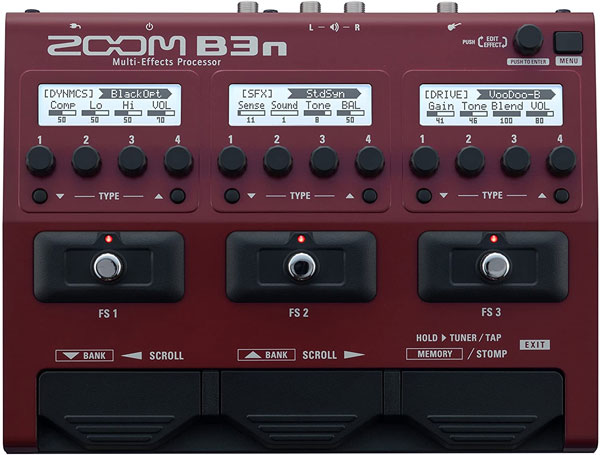
Estimated Price: $220
Type: Digital multi effects Processor
Effects: 62 digital effects + 5 amp and 5 cabinet simulations
I/O: 1x¼” input, 1×3.5mm aux input, 1x¼” output L/Mono/headphone out, 1x output R, USB micro B port, 1x¼” control in
Power: 500mA@9V PSU only
My Review: The B3n is the successor of ZOOM’s popular B3 multi effects pedal. It features 67 tweakable DSP effects stored in 150 patches that allow up to 7 simultaneous effects. Of the 150 patches, 75 are set and cannot be altered (memory mode), the remaining 75 are yours to modify as you see fit (stomp mode). It also has 5 amp, and 5 cabinet simulations, modeled after famous bass rigs from the likes of Aguilar, Ampeg, SWR, Fender, and Trace Elliot, more amp models and effect patches can be downloaded via the USB port and the ZOOM GuitarLab software. There’s also an 80-second looper and 68 drum patterns to choose from when jamming. The foot switches located on the top row are used to turn individual patches on and off, while the bottom row of switches is used to scroll between memory banks and to switch between the memory and stomp modes.
When in Stomp mode, the B3n gives you complete control over the selected patch, it lets you alter the signal chain, adding or deleting effects as well as determining the order you want the effects to be in. There are a multitude of effects to play around with: 15 overdrive and distortion effects, 17 modulation effects, 19 filter and dynamics based effects, and 11 delay and reverb effects. Getting everything out of the B3n requires you to spend some time reading the manual, but once that’s done, setting it up to your liking is fairly straightforward. The numerous customization options let you tailor the patches to your liking, so the tones it has on offer depend mostly on how much time you’ll spend tweaking the 75 patches in the stomp mode. The B3n has a very low noise floor being almost silent in most situations.
Key Specs: The B3n is a good quality digital multi effects processor housed in a rugged aluminum enclosure. It features 62 effect types with 5 amp and 5 cabinet simulations in 150 patches of which 75 are user-definable. It has a 80-second looper and a 68 pattern drum machine. The B3n lets you jam to your favorite backing tracks through the 3.5mm aux input. It also has true stereo operation with ¼” Left/ Right outputs. The L/mono output doubles as a headphone output. The control input lets you connect an expression pedal but there are compatibility issues with 3-rd party offerings.
Target Customer: The ZOOM B3n is a very versatile pedal and would be a good companion for a more advanced bass player. It offers a good variety of usable sounds and it’s a great studying and recording tool.
Bottom Line: The B3n is an all-round performer, its multitude of effects, the 80-second looper, and the 68 pattern drum machine, will richly reward those willing to dedicate some time to studying the manual.
5. Fender Downtown Express Multi Effects Pedal
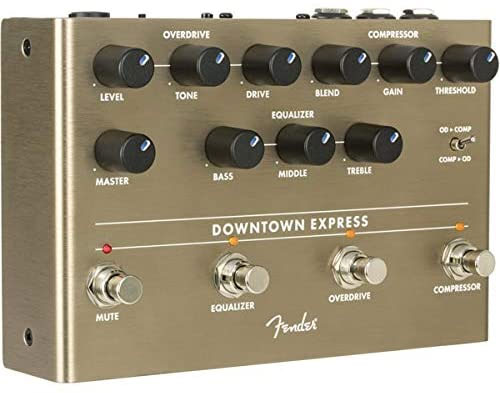
Estimated Price: $250
Type: Analog multi effects Pedal
Effects: Preamp/EQ, Compressor, Overdrive
I/O: 1x¼” input, 1x¼” output, 1x¼” tuner output, XLR balanced output
Power: 400mA@9V PSU
My Review: The Fender Downtown Express is an all-analog multi effects pedal, co-designed by Aguilar Amplification founder Alex Aguilar, specifically with bass players in mind. It combines a preamp with an active 3-band EQ, an overdrive with a cabinet simulation, and a compressor into a well-built and sturdy aluminum enclosure. All three effects are independent of each other and can be engaged separately or stacked one on top of the other. The Downtown express features four footswitches, one for each of the three effects, and a dedicated mute switch that only sends a signal to the tuner dry output when engaged.
All the control knobs are LED-backlit making them easy to see on the darkest of stages, the LEDs can be turned off with the LED killswitch found on the front of the pedal. The EQ section is controlled with the 3 knobs for Bass, Middle, and Treble, the Equalizer footswitch engages or bypasses the EQ. The compressor section has 3 control knobs: Threshold adjusts the sensitivity of the compressor (how loud you have to play for the compression to kick in), Gain controls how much of your signal is fed into the compression circuit (the gain reduction indicator LED will light up when gain reduction or compression is occurring), and Blend lets you mix the compressed signal with you unaffected one (fully clockwise gets you a wet, compressed signal only).
The Overdrive section also has 3 control knobs: Drive determines the amount of saturation added to your signal, Tone adjusts the treble content of your distorted signal, and Level sets the output volume for the overdrive section. The Master control knob adjusts the overall output level. You can also choose in what order the overdrive and compression circuits are in the signal path, with the OD/COMP switch. As a bonus, the Downtown Express has a balanced XLR DI output with a speaker cabinet simulation (when the overdrive is engaged) for a warm, tube-like sound when you run your signal into a mixing console, PA, or audio interface.
On the front of the pedal you’ll find the DI signal path switch that lets you choose what part of your signal goes to the DI: only the affected signal, affected signal + EQ, or completely dry signal. The variety of tones you get from the Downtown Express is surprising. The overdrive delivers a wide range of tube-like sounds from vintage, warm, and harmonically rich to the downright violent, heavily compressed, almost distortion-like tones. The EQ brings even more versatility to the table, enabling you to carefully sculpt your clean tones as well as overdriven tones. The compressor functions more like a sustainer with low compression ratios, but it does its job very well.
Key Specs: The Downtown Express is a well-thought-out, analog multi effects pedal with an active 3-band EQ, a compressor, and an overdrive circuit. The three effects have individual footswitches and function completely independently from each other. The dedicated mute footswitch lets you tune in silence if you connect your tuner to the tuner output, otherwise, it’s just a killswitch for the pedal. It also features a versatile XLR DI out with a ground lift switch, and it lets you choose what part of your signal gets routed to the DI. It only runs on a 9V PSU, drawing 400mA.
Target Customer: The Downtown Express is aimed at analog enthusiasts of all experience levels. The simple control layout is easy and intuitive to operate, for beginners and pros alike. The sound quality is very good, with very low noise levels, making it an ideal companion in the studio as well as live situations.
Bottom Line: The Downtown express is not the most versatile pedal on this list but it performs well above its asking price. It’s a well-built unit, offering solid bass sounds, and it has a wide range of tweaking and routing options.
Popular Related Article: Top 10 Bass Preamp Pedals
6. ZOOM MS-60B Multistomp Multi Effects Pedal
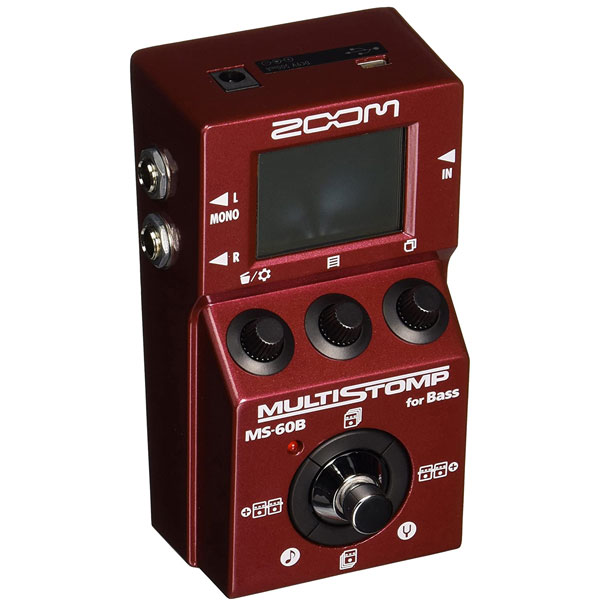
Estimated Price: $120
Type: Digital multi effects Processor
Effects: 52 stompbox effects, 6 amp models
I/O: 1x¼” input, 1x¼” L/MONO output, 1x¼” R output, USB Port
Power: 500mA@9V PSU or 2 AA batteries
My Review: The MS-60B is the most compact multi effects processor in pedal-format you will find. ZOOM has crammed a B3 bass processor into an enclosure the size of a single effects-sized stompbox and also expanded on its capabilities, adding the ability for a fourth simultaneous effect. The MS-60B features 52 stompbox effects and 6 amp models, stored in 80 patch memories, of which 50 are user-defined, while the remaining 30 can not be altered. You can also create a list of 26 patches to cycle through as you press the MS-60B’s footswitch. This function is very useful in practice, when you have a predefined order for your effects, as you’re playing through a known setlist, for example.
The control layout is fairly simple to use, there are three control knobs that also have a push function, a footswitch, and four cursor buttons located around the footswitch. The cursor buttons let you scroll through your patches. Once you’ve selected your desired patch, you can add up to 4 effects into the signal chain in any order you desire. Their parameters will be displayed on the LCD screen and can then be altered using the three control knobs. There are a multitude of effects types to play around and experiment with: 19 dynamics and filter-based effects (compressors, EQs, filters, exciters, and frequency splitters), 11 boosters and overdrives, 14 different modulation effects (phasers, flangers, tremolos, pitch-shifters, choruses), and the 6 amp emulations based on famous units from the likes of Ampeg, Fender, Aguilar or MarkBass. The sounds on offer are very good, and once you dive into its deeper functions, you can pretty much get anything out of this little powerhouse of a pedal.
Key Specs: The MS-60B is a digital multi effects processor housed in a standard stompbox-sized enclosure. It features 52 different stompbox effects and 6 amp emulations. The four cursor buttons placed around the single footswitch, let you navigate through the menus while pressing two of them at the same time, gives you access to the built-in tuner with two tuning modes. The three control knobs let you adjust the parameters of the different effects in your patch’s signal chain. The MS-60B has a ¼” input and two outputs for true stereo operation. The USB port lets you upgrade the firmware and also power the pedal. It runs on a 9V standard PSU or on 2 AA batteries with about 7 hours of continuous playing.
Target Customer: The MS-60B is a feature packed stompbox-sized digital multi effects processor. It is fairly easy to set up and start playing right away, but to get the most out of it you’ll need to spend some time with the manual. It can be a little confusing sometimes with the shared control functions making it better suited for more advanced bass players.
Bottom Line: The MS-60B Multistomp is an impressive feat of engineering. It offers great sounds and customization options in one of the smallest packages around. If you are looking for a fully-featured compact multi effects unit that does not break the bank, take a look at the MS-60B.
7. Valeton Dapper Bass DI
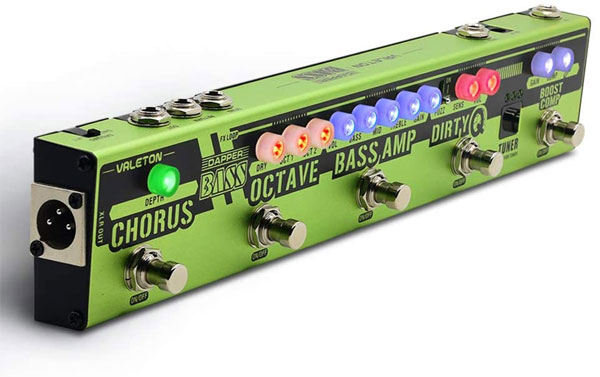
Estimated Price: $150
Type: Analog multi effects Pedal
Effects: 5 analog effects
I/O: 1x¼” input, 1x¼” output, 2x¼” effects loop, ¼” signal through, XLR DI out
Power: 85mA@9V PSU
My Review: Valeton is a US-based manufacturer that has made a name for itself building hardware for other companies. With the Dapper Bass DI, they have created a compact, analog, “fly-rig”-style, multi effects pedal with 5 built-in effects, each with its own footswitch. As you engage each module of the pedal, the corresponding control knobs light up making it easy to know what’s turned on at any given time.
First in the signal chain is the Boost/Compression module. It features Two control knobs and a footswitch that also activates the built in tuner when you press and hold it for a couple of seconds. The Comp knob controls the amount of compression, and the Gain knob sets the amount of boost, for up to +12dB of gain.
The next module in the signal chain is the “Dirty Q”. This section is an envelope filter to which you can add a fuzz circuit by flipping the fuzz switch. The Volume knob sets the overall output of the module, and Sense determines the sensitivity and range of the filter (turn it clockwise to reduce the volume needed to engage the filter while increasing its bandwidth).
The “Bass Amp” module has a footswitch and a 3-band active EQ that lets you boost or cut the Bass, Mid, and Treble frequencies. The Gain knob adjusts the amount of overdrive and saturation, and the Volume control sets the output volume of the Bass Amp module.
The Octave module features a footswitch and 3 control knobs: Oct1 sets the volume of the signal that is one octave below your played note, Oct2 sets the volume for the 2-octave below signal, and Dry controls the level of your unaffected signal that is mixed with the two octave sounds.
The last module in the signal chain is the Chorus. It has a footswitch to engage it and a Depth control knob to set the depth of the chorus effect.
I/O wise the Dapper offers a lot of routing options, besides the standard ¼” in and out, you have the ¼” dry through that lets you send a completely dry signal to a different amp or audio interface, and there’s also an effects loop that lets you add in other effects between the Bass Amp and Octave modules. The balanced DI XLR output enables you to play entire gigs without the need of a bass amp by plugging directly into the PA system or mixing console, it’s also a great help while recording as you have the option to get a dry signal from the “Dry Thru” output and create a mix of the two signals ensuring minimal loss of your fundamental tone.
The sounds you can expect from the Dapper Bass DI range from the subtle to the all-out weird. The filter module is very sensitive to your playing style, and the addition of the fuzz circuit only makes it more versatile. The Bass amp lets you shape your tone to your liking with warm, tube-like overdrive, almost sounding like a distortion pedal at more extreme settings. The Octaver tracks fairly well and together with the filter module gets you great synth sounds. The chorus is the cherry on top of this analog multi effects cake. The compressor is based on an Optical compression circuit and does its job as it should. The noise levels are very low considering this is an analog pedal.
Key Specs: The Dapper Bass DI is a solidly built analog multi effects pedal with 5 integrated effects designed for bass players. Each of the 5 effects has its own footswitch to toggle on and off. As an extra, there’s also a built-in tuner, engaged by holding the Boost/Comp footswitch. All control knobs are LED-backlit, and they light up only when their corresponding module is engaged. Its I/O options are fairly comprehensive, featuring an FX loop, a Dry thru output, and balanced XLR DI out with a ground lift switch. It draws 85mA from a 9V Power supply only.
Target Customer: The Dapper Bass DI is an ideal companion for all aficionados of analog bass pedals. The layout is simple to understand and use, without the need to consult the manual making it well suited for inexperienced bass players. Its small size and good sound quality will also appeal to gigging bassists of any music genre, who are looking to travel light.
Bottom Line: The Dapper Bass DI is a good quality analog bass pedal, that offers premium bass tones at a very low price. Taking into consideration that you get 5 analog effects plus a DI for the price of some single-effect stompboxes, make this pedal very hard to overlook.
Popular Related Article: Top 10 Bass Distortion Pedals
8. Zoom B1XFour Bass multi effects Processor
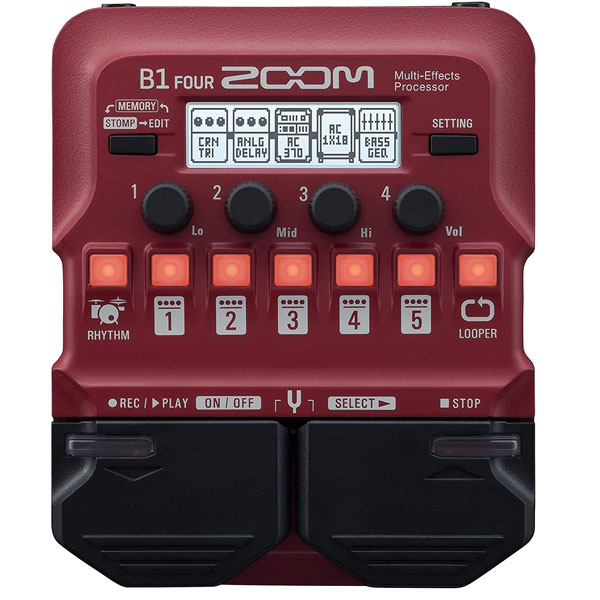
Estimated Price: $110
Type: Digital multi effects Processor
Effects: 70 effects, 9 amp models
I/O: 1x¼” input, 1x¼” output/headphone output, 1×3.5mm aux input
Power: 500mA@9V PSU or 4AA batteries
My Review: The B1XFour is a digital multi effects processor designed for use with the bass guitar. It comes loaded with 70 effects types, 9 amp models to simulate classic bass rigs, a looper with up to 30 seconds of looping time, and 68 drum beat patterns. The B1XFour comes with 39 preset patches in a variety of styles. You can alter them as you please and save them in the 50 available patch memory slots. It lets you add up to 5 simultaneous effects to the signal chain, in any order that you choose to. The “X” in the B1XFour’s name stands for the expression pedal, and you can assign any parameter to it. The individual effects are stored in 5 memory banks selected with the push buttons marked 1 to 5 on the faceplate, you then scroll through them with the two footswitches.
The individual parameters of the chosen effect can be tweaked using the 4 control knobs, the LCD screen displays what parameter each knob affects. The drum machine has a dedicated button on the left side of the 5 memory bank buttons, and the looper also has its own button on its right side. There’s an aux input that lets you jam to your favorite backing tracks and the ¼” output jack doubles as a headphone output for silent operation. This is one of the simplest multi effects pedals you’ll find, making it a breeze to operate most of its functions without referring to the manual.
The built-in tuner is accessed by pressing both footswitches at the same time. As with all ZOOM pedals of the “B” line, the sound quality is very good with extremely low noise levels. The sounds you get out of the B1XFour range from the subtle up to the extreme, but in the end, what you get out of the pedal depends on how much time you spend learning its deep customization functions. As a rule of thumb, the pedal has a good variety of pertinent sounds.
Key Specs: The B1XFour is a compact digital multi effects processor with 70 different effect types, 9 amp models, a 30-second looper, and a 68 pattern drum machine. You can assign any parameter of an individual patch to be controlled by the expression pedal. It features a ¼” input, a ¼” output that also serves as a headphone output, a 3.5mm aux in, and a USB port that lets you update the firmware, or download new patches and amp simulations through the Zoom Guitar Lab software. It can run on a standard 9V PSU or on 4 AA batteries giving you about 18 hours of battery life with the LCD screen turned off.
Target Customer: The B1XFour is geared towards the entry-level segment of bass players. Its simple layout and design make it easy to just plug and play straight out of the box, but more advanced features will require a bit of time spent reading the documentation.
Bottom Line: The B1XFour is a solid performer, with a good variety of effects, tweaking options, and a price tag that makes it very competitively priced for what it brings to the table.
9. MXR Sub Octave Bass Fuzz
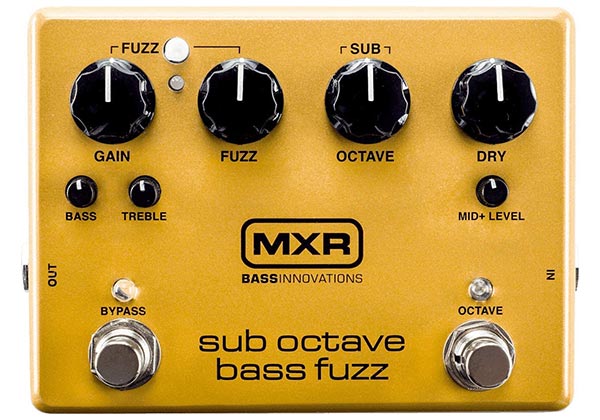
Estimated Price: $200
Type: Analog effects pedal
Effects: 2 effects
I/O: 1x¼” input, 1x¼” output,
Power: 55mA@9V PSU or 9V block battery
My Review: The MXR Sub Octave Fuzz is an all-analog bass effects pedal with 2 powerful and versatile effects. It features two of the most popular bass thickening effects: a Fuzz circuit and an Octaver circuit. It’s built to the highest standards MXR is already known for, housed in a tank-like cast aluminum enclosure. On the left side, you’ll find the Fuzz section with four control knobs for Gain (controls the intensity of the fuzz effect), Fuzz (controls the volume of the fuzz signal), Treble (cuts or boosts the Fuzz effect’s high-end frequencies), and Bass (cuts or boosts the Fuzz effect’s low-end frequencies).
The Fuzz section also has a push-button to switch between the two different fuzz voicings. The Octave section has three control knobs, Sub-Octave (controls the volume of the sub-octave signal), Dry (sets the volume for your unaffected signal), and Mid+Level knob (sets the dry signal’s midrange boost). The Bypass footswitch engages the Fuzz section while the Octave footswitch engages the Octaver section. The two effects sound excellent on their own, but combine them and you get wall-shaking lows and a heavily compressed, distortion sound. Turning up the Gain knob does increase the noise floor significantly, but at moderate settings, it’s almost silent.
Key Specs: The MXR M287 is an all-analog bass effects pedal with 2 stackable effects: a Fuzz and an Octaver. The Fuzz section features a 2-band EQ with Bass (+/- 10 dB@420Hz), and Treble (+/-10dB@4.3kHz). It features independent footswitches to engage the two sections independently and it runs either on a 9V battery or a standard 9V PSU
Target Customer: Although it’s not a true “multi-effects” pedal, as it has only 2 effects, it does sound extremely well. It offers lots of good fuzz and octave sounds that you can stack and the 2-band EQ enables you to shape your tone in a variety of ways with pleasing results. Its simple layout and control scheme will satisfy pro bass players and won’t scare novices away.
Bottom Line: If you are looking for a pedal that will let you literally bring the house down around you, take a look at the Sub Octave Bass Fuzz, it could be your cup of tea.
Popular Related Article: 11 Amazing Bass Compressor Pedals
10. Zoom B1on Bass Multi-Effects Pedal
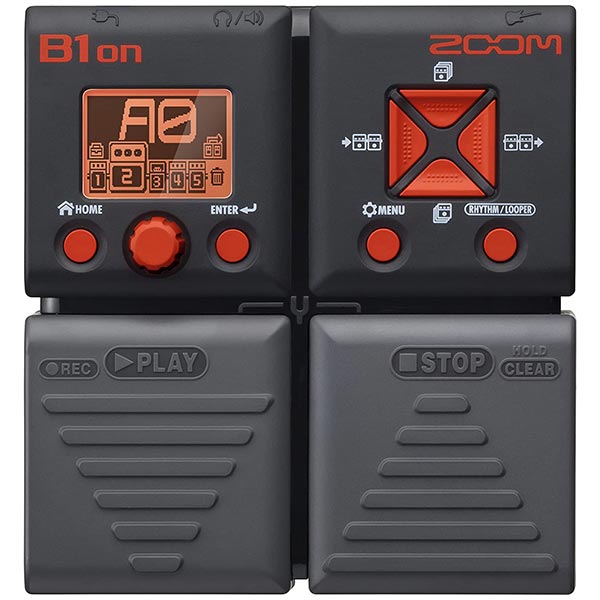
Estimated Price: $100
Type: Digital Multi-Effects Processor
Effects: 75 effect types and amp models
I/O: 1x¼” input,1x 3.5mm aux input, 1x¼” output/headphone out, USB-B port
Power: 500mA@9V PSU (not included) or 4 AA batteries
My Review: The Zoom B1on is a compact digital multi-effects processor that packs a lot of punch. It features 75 effect types including 5 amp emulations of legendary bass rigs, a plethora of distortion, overdrive, compression, modulation, delay, and reverb effects, a 30-second looper, and a drum machine with 68 drum patterns. Individual effects are stored in 100 user-defined memory patches, divided into 10 banks of 10 patches. The B1on lets you chain up to 5 individual effects, in any order you like, giving you complete control over your sounds.
It has 2 footswitches that let you scroll through your patches one-by-one, and they engage the on-board tuner when pressed together. The layout is easy to navigate and most basic functions can be performed without referring to the manual. There’s a dedicated button for the looper/rhythm patterns. The 3.5mm aux in lets you jam to your favorite backing tracks, and the output doubles as a headphone out so you can practice without waking up the neighbors. The customization options are quite varied, and once you dig into the deep functions of the effect you’ll find a wide range of usable sounds. As with most digital multi-effects units, how much time you spend learning its ins and outs is directly proportional to what you can get out of it.
Key Specs: The B1on is a well-built, compact multi-effects pedal with 75 different effects types and the ability to fully customize your signal chain with up to 5 simultaneous effects. It features a 30-second looper, a 68 pattern drum machine, and a built-in tuner. It runs on a 9V PSU delivering at least 500mA of power or on 4 AA batteries delivering up to 20 hours of playing time.
Target Customer: The B1on is an entry-level multi-effects pedal, best suited for practicing at home. It’s a great studying tool thanks to the built-in looper and the aux-in jack.
Bottom Line: If you are looking for a simple, straightforward effects pedal, with a good range of sounds, that won’t break the bank, take a look at the B1on. If you’re looking for the best bass multi effects pedal for under 100 dollars, this should be a top contender.
Choosing the Right Bass Multi Effects Pedal (Buying Guide)
This section is for those of you who want to learn more about multi effects processors before learning reviews.
Multi Effects Processors Come in Three Basic Formats
Floor-based units: with footswitches, intended to be operated by foot, and geared towards playing live
Tabletop units: better suited for use while recording in the studio
Rack-mounted units: designed primarily for the studio and recording, but often have the option to connect an external footswitch controller to enable live playing
In this article, we’ll focus more on floor-based processors as they represent the majority of multi-effect pedals you’ll encounter.
What is a bass multi effects pedal?
Simply put, a bass multi effects pedal will bring together a multitude of dedicated bass effects into a single physical unit. This makes them fairly compact and lightweight when compared to a pedalboard sporting the same number of effects. One of the main advantages of multi effects processors is the price, they usually come at a fraction of the cost of a pedalboard that would provide the same functionality.
Considerations and Factors to Consider
First and foremost, you should think about how you will use your multi effects processor.
If you are getting a multi effects pedal to experiment at home with the different kinds of effects, then an entry-level unit with a decent selection of effects might suit you just fine.
For a gigging musician, sound quality, functionality, and build quality are paramount, so you will probably be best served with a more high-end unit, with more effects, more routing options, and more footswitches so that you have your effects ready to go without having to fiddle around with different memory banks.
If you are getting a multi effects processor for recording and studio use, then sound quality should be your main focus, but keep in mind that more output options like DI’s and dry outputs will make your life much easier when you’re trying to get that perfect tone in the studio.
What effects do you want to use? If your preferred style of music requires basic effects without using more than a couple at the same time, then a simple, newcomer-friendly effects pedal would do the job just fine, but if you’re looking for more eccentric soundscapes, you will probably have to look at the premium segment of effects processors to get what you want out of it.
Analog vs Digital
The majority of multi effects pedals you will encounter are digital signal processors, but there are also analog units on the market. Analog multi effects first appeared in the early 1980s out of convenience, helping to reduce the size and clutter of traditional pedalboards. Their sound quality is comparable to single effects units but they have a few drawbacks. Usually, they don’t let you customize the order of effects in the signal path, they offer a much smaller number of onboard effects and you still have to manually alter the sound every time you want a different setting. There’s no saving of your sounds or memory banks here.
Digital effects processors rely on digital signal processing and emulations of analog effects to produce their sound. They were created with the specific purpose of letting you carry an entire pedalboard’s worth of effects (usually much more than that) in your gig bag. They usually let you customize the order of effects in the signal processing chain and they let you save your settings once you’ve found the tone you were looking for.
Effects Explained
Here’s a breakdown of the most common effect types you’ll find on a multi effects processor:
EQ: Though it can not really be considered a true effect, it’s still one of the main weapons in your arsenal when crafting your clean sound. But in a bass multi effects unit, it’s indispensable. As many effects tend to enhance or detract some part of the frequency spectrum, be it high or low-end, an EQ will let you cut or boost certain frequency ranges to alleviate this problem.
Compression: A compressor is one of the most important effects for a bass player. Although similar to the EQ in that it doesn’t change the pitch or harmonic content of your tone, what it does is it evens out your sound. It reduces your dynamic range, making loud sounds quieter and quiet sounds louder. This has the benefit of adding sustain and evening out your volume when switching between playing styles, but mistakes in playing will also be enhanced.
Overdrive: This effect simulates increasing the gain on a tube amp, resulting in a slight distortion with increased harmonic content.
Distortion: In essence, Distortion is a more pronounced overdrive. The clipping it simulates is more pronounced, the harmonic content is vastly increased and you also get more compression (your playing style will not dramatically change the volume of your notes).
Delay: A delay effect will duplicate your original sound input and repeat it after the original sound has been played. It creates an “echo” effect. The time between repetitions, as well as the number of repetitions, can be altered.
Phaser: A phaser will duplicate your original signal and then play it back but out of phase with the original while modulating it. This creates a “whooshing” sound.
Chorus: Chorus is a type of modulation effect that will copy your signal multiple times, coloring the copies slightly and then playing them back but slightly delayed. The result is a full, shimmery ensemble of “bass voices” simulating the sound of multiple basses playing the same part.
Reverb: Compared to delay, a reverb effect is much subtler. The delay times are usually short and it focuses on replicating the natural sound of a specific space, like a small room, or a cathedral, and everything in between.
Tremolo: A tremolo is an effect in which your signal’s volume is modulated. It’s as if you were quickly turning your volume down and up again.
Vibrato: This is an effect that modulates the pitch of your signal. It is characterized by the amount by which your pitch is modulated, and the speed with which the pitch is varied.
Octaver: An octaver is a type of effect that grabs your input signal and creates a synthesized signal one or more octaves higher or lower from the original signal. You can then mix it with the original signal or choose to play only the synthesized signal. The synthesized octave signal is created by halving (octave down) or doubling (octave up) the original frequency.
Envelope filter: Sometimes called an auto-wah, an envelope filter uses resonance to enhance certain frequencies depending on your playing dynamics – how hard you pluck your strings. Usually, an envelope filter is set to gradually open up as your signal gets louder, then after the signal peaks, it will gradually close again. The filtering effect being dependent on the way you play your bass, you can learn to play your filter pedal using your playing dynamics. Envelope filters are often described as producing vowel-like, screaming, or quacking sounds.
Looper: A looper will let you record a short phrase (sometimes a few minutes long) and then seamlessly play it back in a loop. You can then jam on top of your recorded riff or choose to layer new phrases on top of your first recording.
Pedal Features
There are a few features you’re likely to find on multi effects processors.
Amp emulation: Some multi effects units come with different amp emulations. These let you reproduce the characteristic tone coming from legendary amps, such as vintage Ampeg tube rigs, Fender, Mesa Boogie (whatever the manufacturer chooses to emulate). They bring color to your tone and make it possible to play a gig without the need for an amp, while still having big sounds on offer.
DI: This takes the unbalanced, high impedance signal from your instrument and turns it into a balanced, low impedance signal. This means that you can send the signal directly to the console or into the P.A., without the need for an amp.
Tuner: You will be hard-pressed to find a multi effects pedal without a tuner onboard, its name implies what it does: it lets you tune your instrument.
Digital connections: There are a variety of digital connections found on digital multi effects pedals, some let you control the unit externally for increased flexibility while others function as audio interfaces enabling you to record directly into a DAW without the need for other hardware.
USB: A USB connection can be used to update the device as well as record straight into your computer. It usually gives you access to editing software, in many cases making sound editing much faster than on the unit itself.
MIDI: These ports are found on more expensive multi effects pedals. They let you control your pedal remotely from a PC or a MIDI controller.
S/PDIF: Although it is well known and often found on HI-FI audio equipment, it is less common on multi effects pedals outside of the premium price range. S/PDIF allows you to send your audio signal digitally to an audio interface or a mixing desk.
Here are a few pros and cons of multi effects pedals:
Pros
- Size – one of the main reasons for getting a multi effects pedal is the compact size when compared to a traditional pedalboard. The majority of pedals will fit into a generous gig bag pocket.
- Number of effects – most multi effects pedals come with dozens of different effects and combinations thereof.
- Cost – even the most highly-priced multi effects pedals cost less than their equivalent analog pedalboards.
- Memory – once you’ve found your perfect sound you can just save it and recall it instantly when the need arises.
Cons
- Sound quality – this is generally considered to be the main disadvantage of a multi effects processor but it doesn’t apply across the board. Some effects will be virtually indistinguishable from their analog counterparts, while others you will find lacking. And the individual effects vary greatly from one manufacturer to another.
- Ease of use – with analog single effect pedals, you just plug it in, turn a few knobs and find your sound, a multi effects unit usually takes more time to dial in a specific sound or effect.
- Reading the manual – multi effects pedals are less intuitive than analog effects pedals, the first thing you do after you unbox it usually involves reading the manual. Although some multi effects are more intuitive than others.
Reputed multi effects makers:
Some of the biggest names in multi effects processors are Boss, Zoom, Korg, Digitech, Line6, any of these will generally perform well and will have decent enough build quality to last for ages regardless of the price range.

My name is Chris and I’ve had a passion for music and guitars for as long as I can remember. I started this website with some of my friends who are musicians, music teachers, gear heads, and music enthusiasts so we could provide high-quality guitar and music-related content.
I’ve been playing guitar since I was 13 years old and am an avid collector. Amps, pedals, guitars, bass, drums, microphones, studio, and recording gear, I love it all.
I was born and raised in Western Pennsylvania. My background is in Electrical Engineering, earning a Bachelor’s degree from Youngstown State University. With my engineering experience, I’ve developed as a designer of guitar amplifiers and effects. A true passion of mine, I’ve designed, built, and repaired a wide range of guitar amps and electronics. Here at the Guitar Lobby, our aim is to share our passion for Music and gear with the rest of the music community.
